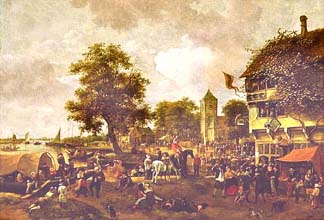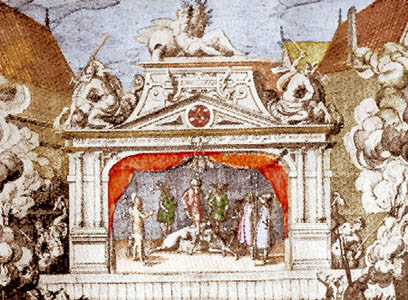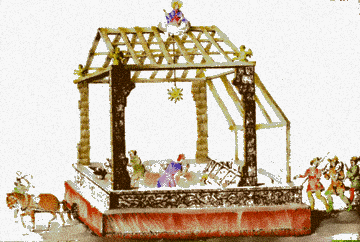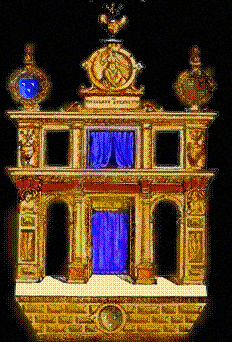
Landjuweels

Formal competition within individual Chambers grew into formal competitions between Chambers. These competitive festivals, called landjuweels (literally "jewel" or "prize of the land"), pitted cities' Chambers against one another in a series of contests strictly governed by rules of form. The first competitions in plays are said to have grown out of the medieval shooting contests in which members of various clubs came together to celebrate and compare skills.
A contest might be held between only two Chambers, but the larger, more prestigious festivals could bring together many orders. For example, in 1498, Antwerp hosted a landjuweel in which twenty-eight Chambers participated.
The first recorded landjuweel took place in Audenarde. In 1413, six societies competed with plays in honor of the Holy sacrament. Following that gathering, several Chambers contributed to a festival of farces in Dunkirk in 1426.
A landjuweel could last for several days or sometimes for several weeks. Performances were open to the public, and by all contemporary accounts, attended enthusiastically. Contestants competed for prizes in a number of categories including: the best play, the best farcical entertainment, the most beautiful blazon, the best acting, the best poem, the best reader of a poem, the best orator, the best song, the best singing, the fool who entertained the best "without villainy". At Haarlem in 1607, there was a prize for the best fireworks display. A typical landjuweel also included a number of parades and banquets. True to the landjuweel's supposed origins, sometimes tourneys were part of the festivity as well.
Edward van Even described the 1561 landjuweel at Antwerp in "Het Landjuweel te Antwerpemn in 1561". According to his account, the city of Antwerp spent more than a hundred thousand guilders on preparations for the festival which lasted an entire month. Nine chambers competed. Van Even reports that the streets "were decorated as for a king."
 |
On the opening day of the landjuweel, August 3, 1561, the members of the Society of the Violet, the host Chamber, "rode outside the city on splendid horses to welcome the visitors. Each member wore a colored mantel and bright plumes and wreaths, and the Fool was dressed so fine he could not recognize himself." The visiting Chamber entered Antwerp in an impressive parade which included 23 triumphal chariots and 197 magnificently decorated wagons. |
| The following day, the city fathers gave a reception for the officers of the societies. The opening ceremonies continued on August 5 with each Chamber's procession to the church, exhibiting their specially designed emblematic blazons, pageant wagons, an allegorical devices. The Fools' competition took place on August 6. The highlight of this competition was a contest to see who could drink the longest draught. Chamber officers held a banquet on August 7. Play competition began on August 8. |
 |
 |
Generally performances took place in a
large hall or on an open platform in the public square.
The platform, which was also used for the performance of
songs, poems, and other entertainments, was backed by an
elaborate architectural facade. Places were reserved on
the facade for a number of shields of honor usually
including those of the emperor or king, of the city, and
of the landjuweel's host society. Thus the facade served
as a way of proclaiming and celebrating the festival's
pedigree rather than providing mere decoration or
realistic backgrounds for the performances. Atop the facade typically was a throne for the figure in whose honor the contest was held. The throne might be occupied by figures representing the Virgin, the Holy trinity, Honor, Wisdom, or Lady Rhetoric. Apparently, these figures were portrayed by human performers at least for part of the festival for contemporary accounts report that several contest featured Lady Rhetoric or Lady Victory descending to the stage in a cloud machine to award prizes. |
On the opening day of play competition for the
1561 Ghent landjuweel, the Society of the Violet, who did not
compete in their own festival, presented a play of welcome. Each
Chamber then presented its entry in the spelen van zinne or theme play category. These presentations lasted
through August 23 when the award for best play was presented in a
dramatized ceremony. The haagspel, a competition for
Chambers who could not afford to enter the main contest. The
landjuweel concluded on September 2 with a farewell play
presented by the Society of the Violet.
Copyright ©
1997 Kelly S. Taylor